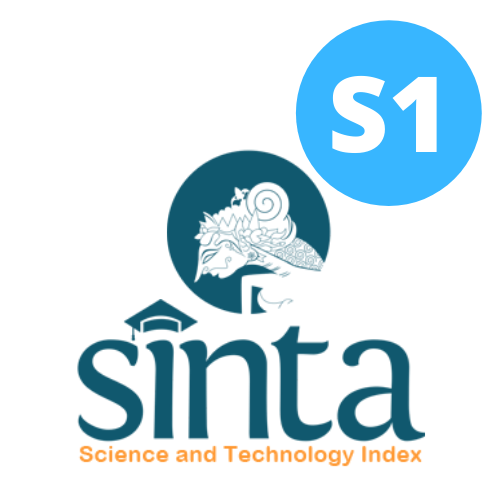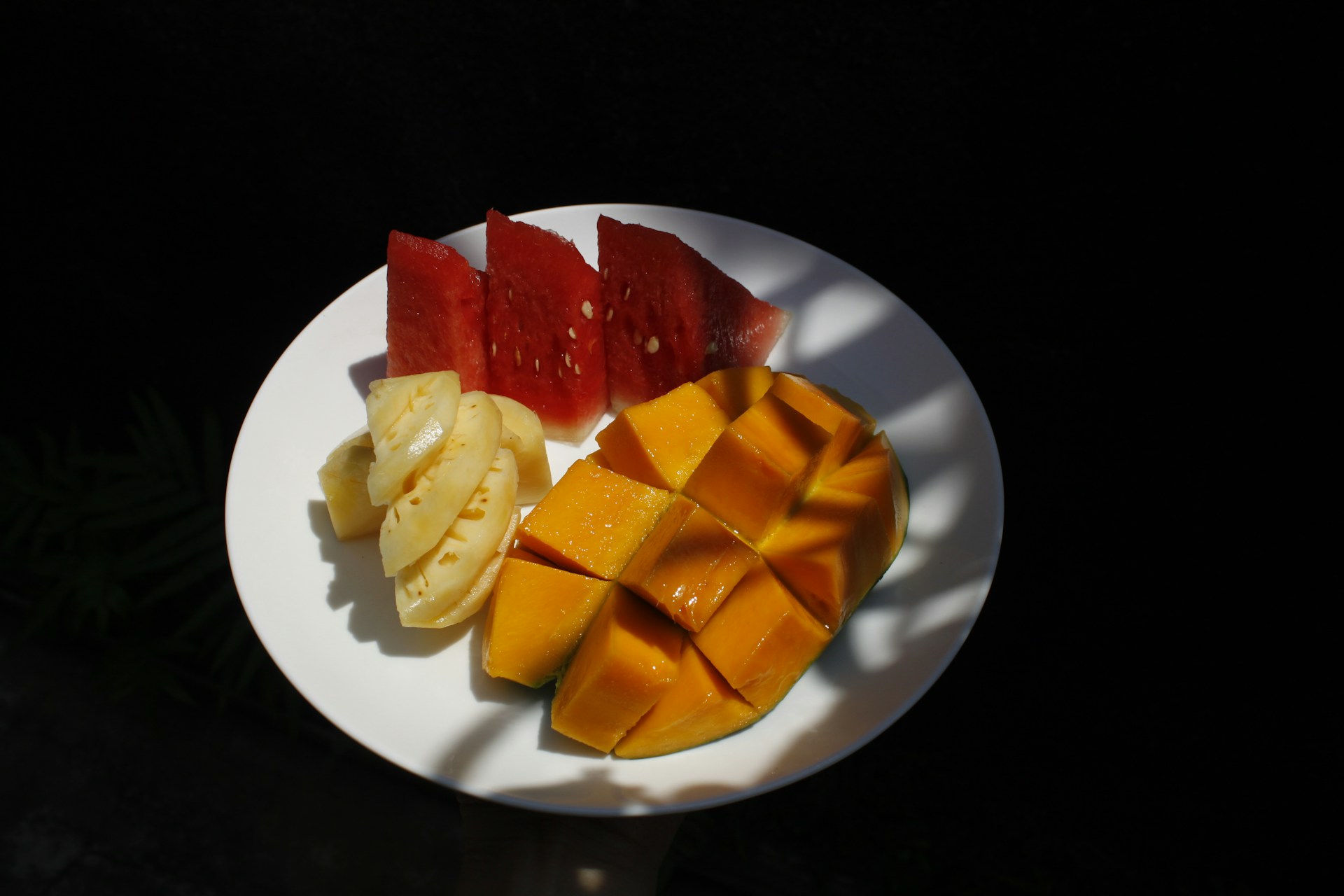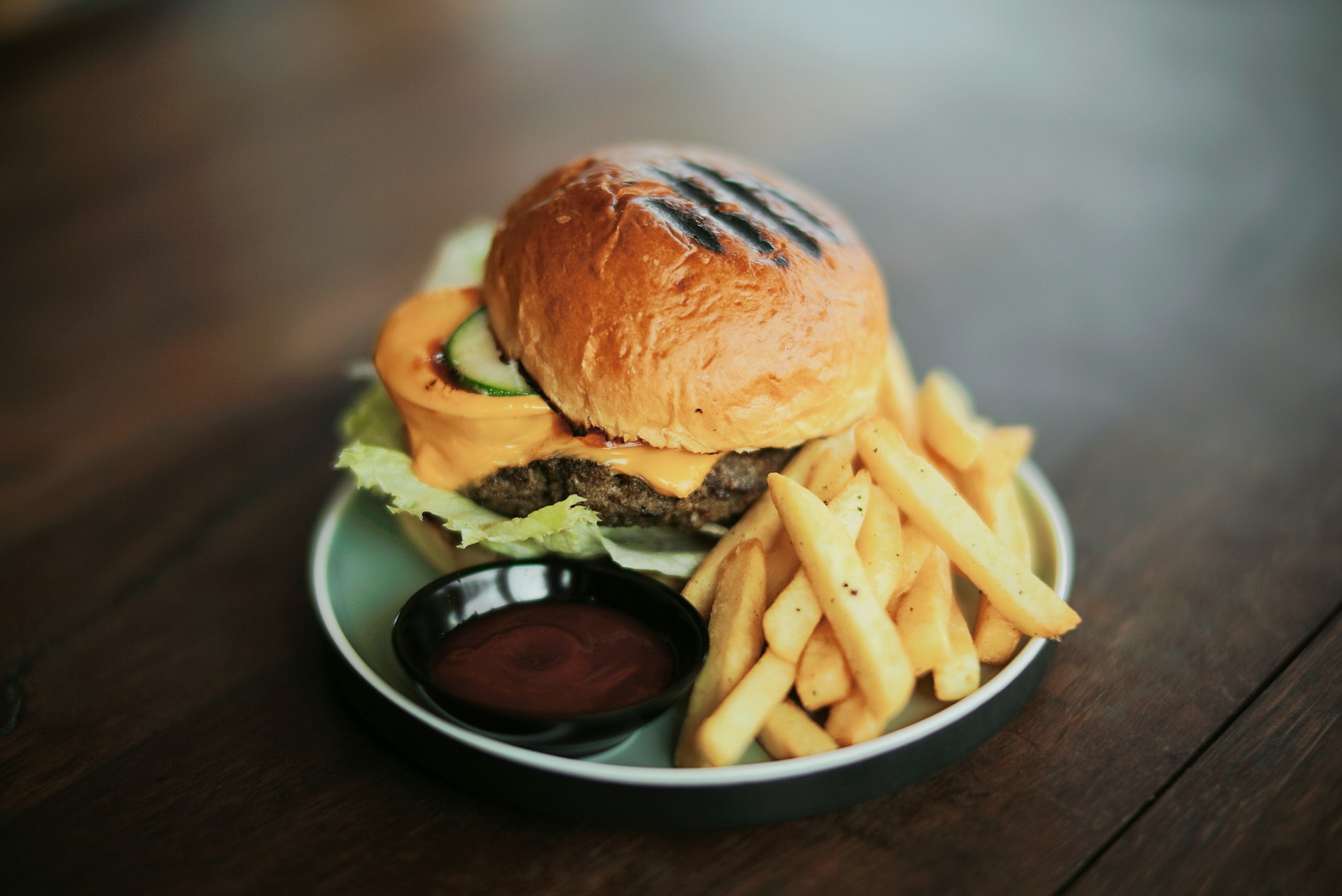The Effect of Food Diversity, Junk Food, and High Sugar Products on The Incidence of Overnutrition in Adolescent of SMAN 6 Depok
Pengaruh Keragaman Pangan, Junk Food, dan Produk Tinggi Gula Terhadap Kejadian Gizi Lebih Remaja SMAN 6 Depok

Downloads
Background: The problem of overnutrition in adolescents (10-18 years) is currently quite high, >15%. Food intake is known to affect nutritional status. Consumption of diverse foods reduces the risk of overnutrition in adolescents. However, adolescents today more often consume poor food intake, such as foods high in sugar, fat, and sodium and low in fiber. It is common knowledge that they increase the risk of overnutrition.
Objectives: To determine the relationship between the habit of dietary diversity, sugary food and beverages, and junk food consumption with overnutrition in adolescents.
Methods: This study employed an observational analytic design with a cross-sectional approach, conducted at SMAN 6 Depok. Data analysis included univariate and bivariate analyses using the chi-square test with a 95% confidence level. The sample consisted of 112 respondents, calculated using Lemeshow's formula for the difference between two proportions and selected using stratified random sampling. Validity and reliability tests with a significance level of 0.05 have been carried out on the questionnaire before being distributed.
Results: The validity test showed validity, and the reliability test showed a Cronbach Alpha value > r table (0.314). Bivariate analysis showed the adolescents did not experience overnutrition (80.4%), adolescents consumed a variety of foods (86.6%), rarely consumed sugary foods (80.4%) and sugary beverages (69.6%), and junk foods (70.5%)
Conclusions: There is no significant relationship between dietary diversity, sugary food and beverages, junk food consumption, and overnutrition in adolescents.
Kristiana, T., Hermawan, D., Febriani, U. & Farich, A. Hubungan Antara Pola Tidur Dan Kebiasaan Makan Junk Food Dengan Kejadian Obesitas Pada Mahasiswa Universitas Malahayati Tahun 2019. Human Care J. 5, 750 (2020). DOI: https://doi.org/10.32883/hcj.v5i3.758.
FAO. The State of Food Security and Nutrition in the World. The State of Food Security and Nutrition in the World 2023 (Roma, 2018). DOI: https://doi.org/10.4060/cc3017en.
UNICEF. Strategi Komunikasi Perubahan Sosial dan Perilaku: Meningkatkan Gizi Remaja di Indonesia. Unicef 1–66 (2021). Available at: https://www.unicef.org/indonesia/media/9251/file/Ringkasan. (Accessed: 2nd February 2024).
Menteri Kesehatan RI. Hasil Survei Status Gizi Indonesia (SSGI) 2022. Kemenkes 1–150 (2022). Available at: https://repository.badankebijakan.kemkes.go.id/id/eprint/4855/3/Buku%20Saku%20SSGI%202022%20rev%20270123%20OK.pdf. (Accessed: 13rd February 2024).
Badan Penelitian dan Pengembangan Kesehatan RI. Laporan Riskesdas 2018 Nasional. (Lembaga Penerbit Balitbangkes, 2019).
Sakinah, I. & Muhdar, I. N. Konsumsi Minuman dan Makanan Kemasan serta Aktivitas Fisik Dengan Kejadian Gizi Lebih pada Remaja Di Jakarta. Nutritire Diaita 14, 8–14 (2022). Available at: https://ejurnal.esaunggul.ac.id/index.php/Nutrire/article/viewFile/4430/3536. (Accessed: 12nd December 2023).
Sony, A. G. C. Hubungan Penggunaan Aplikasi Pesan - Antar Makanan, Asupan Lemak, dan Aktivitas Fisik dengan Status Gizi Lebih Pada Siswa Sman 63 Jakarta. (Universitas Pembangunan Nasional "Veteran" Jakarta, 2023).
Stefani, M. & Layalia, N. Hubungan Penggunaan Aplikasi Pesan Antar Makanan terhadap Risiko Obesitas pada Mahasiswa di Daerah Jabodetabek The Relationship between the Use of Food Delivery Applications and the Risk of Obesity among Collage Students in the Jabodetabek Area. 7, 155–163 (2023). DOI: https://doi.org/10.20473/amnt.v7i2SP.2023.155-163.
Vidyarini, A. & Ayunin, E. N. Keragaman dan Kualitas Konsumsi Pangan pada Remaja Usia 15-17 Tahun. ARGIPA (Arsip Gizi dan Pangan) 7, 31–39 (2022). DOI: https://doi.org/10.22236/argipa.v7i1.7951.
Prasetyaningrum, Y. I., Yuliati, E., Sarinande, A. F. & Rahma, N. L. Gambaran Keragaman Pangan Pada Remaja Di Kota Yogyakarta. Prosiding Seminar Nasional. 4, 114–119 (2022). Available at: https://prosiding.respati.ac.id/index.php/PSN/article/download/433/413. (Accessed: 16th March 2024).
Felinda, V. Hubungan Keanekaragman Pangan dengan Status Gizi Remaja Usia 16-18 Tahun di MAN 2 Kota Bengkulu. (Politeknik Kesehatan Kemenkes Bengkulu, 2021).
Amelia, C. M. & Fayasari, A. Faktor Yang Mempengaruhi Konsumsi Sayur Dan Buah Remaja Di Smp Negeri 238 Jakarta. J. Gizi dan Pangan Soedirman 4, 94 (2020). DOI: https://doi.org/10.20884/1.jgps.2020.4.1.2642.
Yuniarti, E. Hubungan Konsumsi Sayur dan Buah dengan Kegemukan Remaja di Kota Padang. J. Sehat Mandiri 18, 137–145 (2023). DOI: https://doi.org/10.33761/jsm.v18i1.974.
Iqbal, M. & Ngizan, F. N. Hubungan Gaya Hidup “Nongkrong”, Aktivitas Sedentary, dan Konsumsi Minuman Manis dengan Status Gizi pada Mahasiswa. J. Nutr. 25, 1–11 (2023). DOI: https://doi.org/10.29238/jnutri.v25i1.315.
Fatmawati, I. Asupan gula sederhana sebagai faktor risiko obesitas pada siswa-siswi sekolah menengah pertama di Kecamatan Pamulang, Kota Tangerang Selatan. J. Ilmu Gizi Indonesia. 2, 147 (2019). DOI: https://doi.org/10.35842/ilgi.v2i2.113.
Badriyah, L. & Pijaryani, I. Kebiasaan Makan (Eating Habits) dan Sedentary Lifestyle dengan Gizi Lebih pada Remaja pada Saat Pandemi Covid-19. J. Ilmu Kesehatan. 21, 33–37 (2022). DOI: https://doi.org/10.33221/jikes.v21i1.1521.
Suryani, I. S., Sulastri, M. & Hasrinurhidayat. Hubungan Konsumsi Junk Food dengan Status Gizi pada Remaja di Sekolah Menengah Pertama ‘S’. J. Keperawatan Kebidanan 4, 79–84 (2020). DOI: https://doi.org/10.54440/jmk.v4i1.101.
Fahria, S; Ruhana, A. Konsumsi Minuman Manis Kemasan Pada Mahasiswa Prodi Gizi Universitas Negeri Surabaya. J. Gizi Unesa. 02, 95–99 (2022). Available at: https://ejournal.unesa.ac.id/index.php/GIZIUNESA/article/view/45241. (Accessed: 8th January 2024).
Nurbaiti, K. Hubungan Preferensi Makan, Pengaruh Teman Sebaya, Asupan Zat Gizi Makro dan Paparan Sosisal Media Dengan Kejadian Gizi Lebih di SMA Negeri 6 Kota Depok. respository upnvj (Universitas Pembangunan Nasional ‘Veteran’ Jakarta, 2023). DOI: https://doi.org/10.20473/amnt.v7i2SP.2023.31-38.
Li, L. et al. Fast food consumption among young adolescents aged 12–15 years in 54 low- and middle-income countries. Glob. Health Action 13, (2020). DOI: https://doi.org/10.1080/16549716.2020.1795438.
Meisya, Y. D. Skor Keanekaragaman Konsumsi Pangan (Dietary Diversity Score) Remaja di Bandung dan Padang. (Institut Pertanian Bogor 2014).
Menteri Kesehatan RI. Peraturan Menteri Kesehatan RI Nomor 41 Tahun 2014 Tentang Pedoman Gizi Seimbang. (2014).
Irawan, D. H. D. Hubungan Pengetahuan Gizi, Kebiasaan Konsumsi Junk Food, Dan Makanan Berserat Terhadap Status Gizi Siswa Sma N 1 Salaman. (Universitas Islam Negeri Walisongo Semarang, 2022).
Hanun, N. Pengaruh Pendapatan, Jumlah Tanggungan Keluarga Dan Pendidikan Terhadap Pola Konsumsi Rumah Tangga Nelayan Di Desa Seuneubok Rambong Aceh Timur. J. Samudra Ekonomika. 2, 75–84 (2018).
Menteri Kesehatan RI. Peraturan Menteri Kesehatan Republik Indonesia Nomor 2 Tahun 2020 Tentang Standar Antropometri Anak. (2020). Available at: https://yankes.kemkes.go.id/unduhan/fileunduhan_1660187306_961415.pdf. (Accessed: 3rd February 2024).
Rachmayanti, A. Hubungan Pengetahuan Gizi, Besar Uang Saku, dan Kebiasaan Konsumsi Jajanan Terhadap Status Gizi Lebih Pada Remaja di SMAN 80 Jakarta. (Universitas Pembangunan Nasional "Veteran" Jakarta, 2023).
Juliantina, V. Hubungan Emotional Eating, Frekuensi Konsumsi Makanan dan Minuman Manis Terhadap Status Gizi Pada Mahasiswa/I Semester Akhir Fikes UPNVJ. (Universitas Pembangunan Nasional "Veteran" Jakarta, 2022).
Destiani, T., Simanungkalit, S. F. & Fauziyah, A. Determinan Gizi Lebih pada Remaja di SMP YPI Bintaro Jakarta. J. Ilmu Kesehatan Masyarakat. 8, 25–29 (2019). DOI: https://doi.org/10.33221/jikm.v8i01.185.
Telisa, I., Hartati, Y. & Haripamilu, A. D. Faktor Risiko Terjadinya Obesitas Pada Remaja SMA. Faletehan Heal. J. 7, 124–131 (2020). DOI: https://doi.org/10.33746/fhj.v7i03.160.
Hendra, C., Manampiring, A. E. & Budiarso, F. Faktor-Faktor Risiko Terhadap Obesitas Pada Remaja Di Kota Bitung. J. e-Biomedik 4, 2–6 (2016). DOI: https://doi.org/10.35790/ebm.4.1.2016.11040.
Ariesta, M., Mitra, Desfitas, S., Nurlisis & Harahap, H. Hubungan Keanekaragaman Konsumsi Pangan Dan Aktifitas Fisik Dengan Kegemukan Remaja Di SMPN Kampar Kiri Kabupaten Kampar. J. Ners 5, 42–50 (2021). DOI: https://doi.org/10.31004/jn.v5i2.2506.
Widyaningsih, N. N., Kusnandar & Anantanyu, S. Keragaman Pangan, Pola Asuh Makan, Dan Kejadian Stunting pada Balita Usia 24 - 59 Bulan. Amerta Nutr. 7, 22–29 (2018). DOI: https://doi.org/10.14710/jgi.7.1.22-29.
Wantina, M., Rahayu, L. S. & Yuliana, I. Keragaman Konsumsi Pangan Sebagai Faktor Risiko Stunting pada Balita Usia 6-24 Bulan. J. ARGIPA 2, 89–96 (2017). Available at: https://journal.uhamka.ac.id/index.php/argipa (Accessed: 19th March 2024).
Retni & Arfianti, M. Keragaman Konsumsi Pangan Dan Status Gizi Remaja Putri Yang Tinggal Dikos-Kosan. J. Ilmu Kesehat. dan Gizi 1, 108–121 (2023). DOI: https://doi.org/10.55606/jikg.v1i3.1392.
Menteri Kesehatan RI. Peraturan Menteri Kesehatan Republik Indonesia Nomor 28 Tahun 2019 Tentang Angka Kecukupan Gizi Yang Dianjurkan Untuk Masyarakat Indonesia. (2019). Available at: http://hukor.kemkes.go.id/uploads/produk_hukum/PMK_No__28_Th_2019_ttg_Angka_Kecukupan_Gizi_Yang_Dianjurkan_Untuk_Masyarakat_Indonesia.pdf. (Accessed: 27th February 2024).
Pribadi, S. P. & Ruhana, A. Perbedaan Konsumsi Gula Selama Stres Akademik antara Mahasiswi Gizi dengan Mahasiswi Non Gizi Angkatan 2018 Univeritas Negeri Surabaya. J. Gizi Univeritas Negeri Surabaya 3, 409–418 (2023). Available at: https://ejournal.unesa.ac.id/index.php/GIZIUNESA/article/view/53786. (Accessed: 3rd June 2024).
Ferinawati, F. & Mayanti, S. Pengaruh Kebiasaan Makan dan Aktivitas Fisik Terhadap Kejadian Obesitas pada Remaja di Sekolah Menengah Atas Negeri 1 Kecamatan Kota Juang Kabupaten Bireuen. J. Healthc. Technol. Med. 4, 241 (2018). DOI: https://doi.org/10.33143/jhtm.v4i2.213.
Habsidiani, R. A. & Ruhana, A. Tingkat konsumsi gula dan lemak antara remaja obesitas dan non obesitas usia 15-18 tahun di SMAN 1 Kota Mojokerto. J. Gizi Univ. Negeri Surabaya 3, 320–327 (2023). Available at: https://ejournal.unesa.ac.id/index.php/GIZIUNESA/article/view/52983. (Accessed: 19th March 2024).
Herawati, N. tri, Alamsyah, D. & Hernawan, A. D. Hubungan antara Asupan Gula, Lemak, Garam, dan Aktivitas Fisik dengan Kejadian Hipertensi pada Usia 20-44 Tahun Studi Kasus Posbindu PTM di Desa Secapah Sengkubang Wilayah Kerja Puskesmas Mempawah Hilir. J. Mahasiswa. dan Penelitian Kesehatan. 7, 34–43 (2020). DOI: http://dx.doi.org/10.29406/jjumv7i1.
Asriati & Juniasty, H. T. Analisis Perilaku Konsumsi Makanan dan Minuman Manis terhadap Prediabetes Remaja di Kota Jayapura. Prev. J. Kesehatan. Masyarakat. 14, 495–511 (2023). DOI: https://doi.org/10.22487/preventif.v14i3.970.
Hardiansyah, A., Yunianto, A. E., Laksitoresmi, D. R. & Tanziha, I. Konsumsi minuman manis dan kegemukan pada mahasiswa. J. Gizi 6, 20–26 (2017). DOI: https://doi.org/10.26714/jg.6.2.2017.%25p.
Yulia Maulinda, D. Hubungan konsumsi minuman manis terhadap kejadian overweight pada mahasiswa fakultas ilmu kesehatan universitas muhammadiyah surakarta. (Universitas Muhammadiyah Surakarta, 2022).
Prima, T. A., Andayani, H. & Abdullah, M. N. Hubungan Konsumsi Junk Food Dan Aktivitas Fisik Terhadap Obesitas Remaja Di Banda Aceh. J. Ilmu Mahasiswas Kedokteran Biomedis 4, 20–27 (2018). Available at: https://jim.usk.ac.id/FKB/article/view/6754/2782. (Accessed: 27th February 2024).
Annisa, M., Firdaus, T., Atmadja, A.-G. & Susilowati, E. Level of knowledge and habits of junk food consumption with nutritional status in student of Nutrition Study Program at Siliwangi University. Nutr. Sci. Journal. I, 21–29 (2022). DOI: https://doi.org/10.37058/nsj.v1i1.5804.
Tanjung, N. U. et al. Junk Food dan Kaitannya dengan Kejadian Gizi Lebih Pada Remaja. J. Ilm. Kesehat. Masy. 14, 2022 (2022). DOI: https://doi.org/10.52022/jikm.v14i3.343.
Nurhayati, R. & Purwandari, H. Frekuensi Konsumsi Junk Food Dengan Kejadian Menarche Dini Pada Remaja Putri. J. Kebidanan Midwiferia 9, 51–62 (2023). DOI: https://doi.org/10.21070/midwiferia.v9i1.1674.
Bonita, I. A. & Deni, Y. F. Konsumsi Fast Food Dan Aktivitas Fisik Sebagai Faktor Risiko Kejadian Overweight Pada Remada Stunting SMP. J. Nutrition College.6, 360–367 (2017). DOI: https://doi.org/10.14710/jnc.v6i1.16893.
Halid, S. A., Gobel, M., Loulembah, F. & If’all. Mutu Bakso Daging Sapi Ditinjau Dari Kadar Protein, Kadar Lemak, Kadar Air, Total Mikroba, Kandungan Boraks, Dan Formalin Yang Dijual Di Depot-Depot Bakso Daging Sapi Di Kota Palu. J. Pengolah. Pangan 8, 60–65 (2023). DOI: https://doi.org/10.31970/pangan.v8i1.119.
Majabadi, H. A. et al. Factors influencing fast-food consumption among adolescents in Tehran: A qualitative study. Iran. Red Crescent Med. J. 18, 7–9 (2016). DOI: https://doi.org/10.5812/ircmj.23890.
Susmiati, S., Lipoeto, N. I. & Khairina, I. Dietary diversity score and adolescent obesity among West Sumaterans girl. J. Nutrition Clinical. Dietetica Hospitalica. 44, 237–244 (2024). DOI: https://doi.org/10.12873/441susmiati.
Olatona, F. A., Ogide, P. I., Abikoye, E. T., Ilesanmi, O. T. & Nnoaham, K. E. Dietary diversity and nutritional status of adolescents in Lagos, Nigeria. J. Family Meicine. Primary Care (2023) doi:10.4103/jfmpc.jfmpc_1783_22.
Adeomi, A. A., Fatusi, A. & Klipstein-Grobusch, K. Food Security, Dietary Diversity, Dietary Patterns and the Double Burden of Malnutrition among School-Aged Children and Adolescents in Two Nigerian States. Nutrients 14, (2022). DOI: https://doi.org/10.3390/nu14040789.
Isabirye, N. et al. Dietary diversity and associated factors among adolescents in eastern Uganda: A cross-sectional study. BMC Public Health 20, 4–11 (2020). DOI: https://doi.org/10.1186/s12889-020-08669-7.
Hanita. Hubungan Konsumsi Makanan Manis, Asin, dan Berlemak dengan Kejadian Obesitas Pada Remaja di SMAN 5 Depok. (Universitas Pembangunan Nasional "Veteran" Jakarta, 2022).
Qoirinasari, Q., Simanjuntak, B. Y. & Kusdalinah, K. Berkontribusikah konsumsi minuman manis terhadap berat badan berlebih pada remaja? AcTion Aceh Nutrition. J. 3, 88 (2018). DOI: https://doi.org/10.30867/action.v3i2.86.
Ramadhany, R. A., Wahyuningsih, U., Sufyan, D. L. & Simanungkalit, S. F. Determinan Gizi Lebih dan Obesitas pada Remaja Usia 13-15 Tahun di DKI Jakarta ( Analisis Data Riskesdas 2018 ) Determinants of Overweight and Obesity in Adolescent Aged 13-15 Years Old in DKI Jakarta ( Analysis of Riskesdas 2018 Data ). J. Nutrition. 7, 124–131 (2023). DOI: https://doi.org/10.20473/amnt.v7i2SP.2023.124-131.
Laulaulinnuha, D., Sartika, R. S. & Amaliah, L. The Association of Sugar Sweetened Beverage Consumption and Physical Activity with Overnutrition Status of Students in SMP Negeri 13 Serang City Difa. J. Gizi Kerja dan Produkt. 5, 157–163 (2024). DOI: http://dx.doi.org/10.62870/jgkp.v5i1.25661.59.
Damayanti, E. R. & Sufyan, dian L. Hubungan Pola Makan, Aktivitas Fisik, Dan Citra Tubuh Dengan Status Gizi Lebih Pada Remaja Putri Di Sma Negeri 3 Tambun Selatan. Indones. J. Health. Development. 4, 35–45 (2022). DOI: https://doi.org/10.52021/ijhd.v4i1.69.
Mustofa, A. & Nugroho, P. S. Hubungan Tingkat Pengetahuan Gizi dan Junk Food dengan Kejadian Overweight pada Remaja. Borneo Student Res. 2, 1240–1246 (2021). Available at: https://journals.umkt.ac.id/index.php/bsr/article/view/1970/828. (Accessed: 1st January 2024).
Patarru, F., Rosmina, S., Heumasse, C. F. & Ahudara, C. G. S. Kebiasaan Konsumsi Makanan Siap Saji (Fast Food) dan Status Gizi pada Remaja. J. Penelitian Kesehatan. Suara Forikes 13, 234–237 (2022). DOI: http://dx.doi.org/10.33846/sf13nk143.
Mackay, S. et al. Energy, sodium, sugar and saturated fat content of new zealand fast-food products and meal combos in 2020. Nutrients 13, (2021). DOI: https://doi.org/10.3390/nu13114010.
Wijaya, N. V., Dahliah, D. & Pancawati, E. Dampak Kebiasaan Mengonsumsi Junk Food Terhadap Berat Badan. MAHESA Malahayati Heal. Student J. 4, 455–464 (2024). DOI: https://doi.org/10.33024/mahesa.v4i2.13133.
Copyright (c) 2025 Amerta Nutrition

This work is licensed under a Creative Commons Attribution-ShareAlike 4.0 International License.
AMERTA NUTR by Unair is licensed under a Creative Commons Attribution-ShareAlike 4.0 International License.
1. The journal allows the author to hold the copyright of the article without restrictions.
2. The journal allows the author(s) to retain publishing rights without restrictions
3. The legal formal aspect of journal publication accessibility refers to Creative Commons Attribution Share-Alike (CC BY-SA).
4. The Creative Commons Attribution Share-Alike (CC BY-SA) license allows re-distribution and re-use of a licensed work on the conditions that the creator is appropriately credited and that any derivative work is made available under "the same, similar or a compatible license”. Other than the conditions mentioned above, the editorial board is not responsible for copyright violation.












































